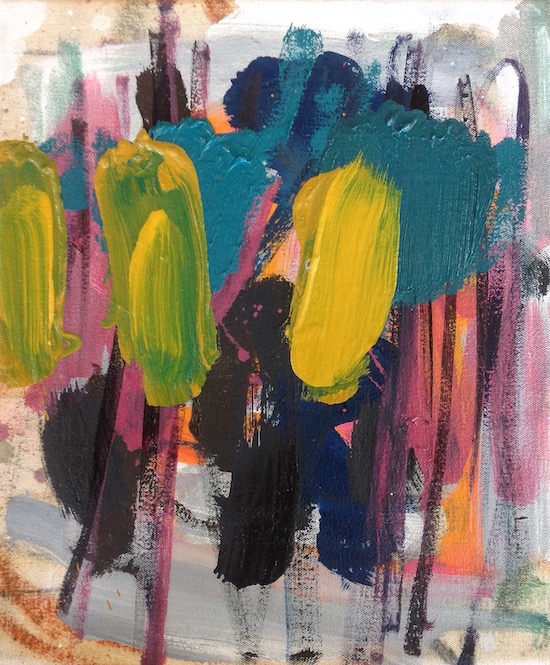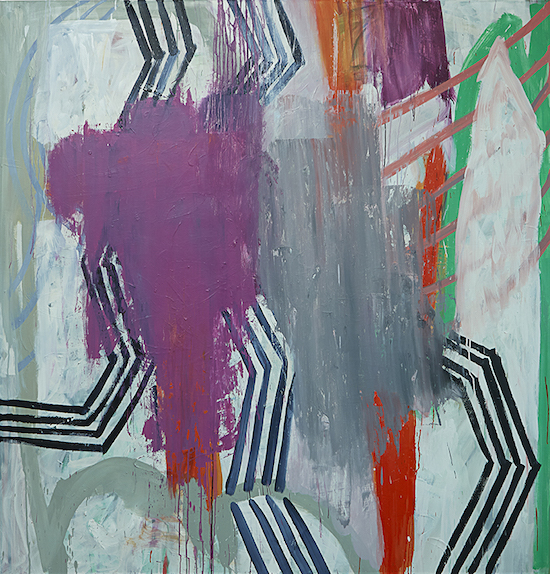A painter for 20 years, Karl Bielik has nurtured his natural sensitivity to colour and developed a broad visual language of mark-making within a process-driven studio practice to create expressive, compelling abstract paintings. He has an industrious exhibition record, having shown his work widely in the UK, Europe, and further afield and recently gained recognition by the UK’s highly respected John Moore’s Painting Prize.
Bielik’s paintings are on show until the end of June in the exhibition ‘Pulp Friction’ alongside painter Jai Llewellyn at Wilderness Projects in De Beauvoir Village. Located in the hair salon Studio Ninety, this salon/gallery is a new alternative art space co-curated by artist Tom Wilmott. He says ‘there is a palpable change and growth going on regarding the quality of art shown and the level of professionalism such spaces and projects aspire to and achieve. Increasingly artists of repute are welcoming the idea of showing work in a non gallery environment and curators are seeking out new places to set up projects, and by extension new audiences for the work they show.’ Such projects bring art into a more publicly accessible realm, and present fresh, exciting, risk-taking exhibitions.
You can find more of Bielik’s paintings in the group exhibition, A Road Not Taken, at the Crypt Gallery in St Marylebone Church presented by the artist-led organisation Contemporary British Painting – and even more paintings in group exhibition, Headcleaner at Southend-on-Sea at arts organisation Metal, who renovated the Grade II listed Georgian building, Chalkwell Hall, from dereliction to create a community hub within the grounds of the much loved Chalkwell Park.
Ahead of his seventh album launch next month and a single release on 29 June, I talk to songwriter and fellow painter Karl Bielik to learn about his enviable talent to create and communicate both visually and musically.
From one painter to another…
LARK, why the name?
Because I sing like I’m up with them, and am having one.
I was deciding whether to use my own name or pick a band name after the first recordings back in 2003. In the end I couldn’t find a name I was happy with so I used an anagram of Karl. It was simple and kept things personal. Most band names are a bit silly but once they stick, somehow they start to fit with the music.
How would you describe your music?
A vanity project for a confused Northerner, lo-fi, tender, raw, DIY, amateur, punk, thoughtful, thoughtless. I never really know musically where I’m heading or have headed until I listen to an album after not hearing it for a while. I’m not playing live and don’t have a set band at the moment but work with musicians who contribute. Not in the traditional fashion of being in the same room and working stuff out, it’s more that I ask if they want to do something, I send a couple of tracks and then get them to do their thing. I then mix it in/edit as needed.
So most of the songs on this album have never been played with a band and they retain a rawness/naivety that is not ironed out during hours of rehearsals. But it goes both ways – some songs just don’t transfer to a live act and some become a whole new force with it.
What are your influences and subjects of inspiration?
Babybird. His early lo-fi albums were a very big influence in attitude and sound, Sparklehorse, Beefheart, Cave, The Fall, Cohen, Waits, I could go on, there are so many and I have a big music collection with catholic tastes. Film, literature, art have all found their way in and out of songs through the last six albums. Subjects can be quite random. On the new album, there is one track based around Once upon a time in the West, plus a couple of more predictable heartbreak songs and a track that is an oblique tribute to Mark E. Smith using only words from the Camus novel that gave them their name. I think that’s enough to give away, there’s got to be some mystery.
What drives you to paint?
I don’t really know. It’s the long game, painting, and I’m only just getting in to my stride – after twenty years. It’s a process-driven thing and directionless in some ways. I just keep chipping away at the coalface, and every now and then it gives me enough back to keep on going, blindly and with faith.

Which came first?
The painting – although I was late to arrive at it – only started for real in 1997 when I lived in Prague. That was the time I first had a studio and actually took myself ever-so-slightly seriously as a painter… I had made stuff for years, but that’s when it really began. The music was later – Ian Parkin from Minor Works Depot gave me his two-track tape recorder in 2003 and I just started recording tracks, making my first CD as Lark when I was 36.
The band kind of came about by accident as I only intended to do the recordings. But it caught the imagination of enough people – musicians and non-musicians – and we put together a band and got signed by Care in the Community Records who put out Lark’s first two albums and 7” singles. We played all the usual haunts and festivals… memorably with Scritti Politti at one of their rare outings, touring Eastern Europe and curating our own nights in small East End venues.
Can you describe your creative, songwriting process?
There is no set way that I write songs, some of the tracks are led by the lyrics or led by a hook… I’m not much of a musician though I do play most things bar the drums. I put a drum machine track down (if there is one) and work from there, adding and remove instrumentation, percussion, things recorded on my phone… most things are recorded clean and then effects added during the mix. The writing, mixing and recording is all done at once and alone, using Protools and an old Digi 002 I bought ten years ago by chance from Matt Johnson of The The.
There is a lot of chance or you could look at it as action and reaction, which is very much a part of my painting process. Make a move, react to move.
And where do you recognise similarities and differences in your painting process?
For me, music is much more instant and more obvious. Painting is slower. I like the difference. The main thing being I paint nearly everyday and the only time I play any instruments is when I am recording an album… obviously different back in the day when Lark were a full band. Technically it can be a pain when I first start a new record but within a few weeks I’ve remembered the little I need to know to make some noise. It’s all adding and subtraction and knowing when to stop in both areas.
Painting, songwriting, and performance are modes of communication and expression. What are you like in these modes?
Painting and songwriting are destined to be public but they start as personal. I can happily just get on with them in my studio. I’m comfortable with them. They are part of me. Performance is a different beast and I don’t perform at the moment.

With LARK’s new album coming out soon, what are you plans for the band now?
A week before the The Last Woman is out there is a single release for ‘Can I Colour in your Hair’ on Lark’s former label with a B-side remix by Andrew Weatherall. There are a few different artists working on videos/films for album tracks, it’s a totally open project and so I have no idea what is going to be coming back… There is talk of a Lark NTS radio show and then next year, after a five-year hiatus, Lark will hit the road again for a few UK and European dates all centred around a date in early March at the 100 Club with The Band of Holy Joy.
And what’s next for your painting? What are you working on in the studio at the moment?
I always have twenty or so pieces on the go in my studio. At the moment I’m working on three large canvasses and a series of small stretchers, works on paper and collages with painted cardboard. I have work in a few group shows that are on at the moment and a solo show coming up later in the year in Belgium.
Karl Bielik’s single ‘Can I Colour In Your Hair
’ is released on 29 June by Care in the Community Records, and his album,The Last Woman, is released on 6 July with Standard Lamp Records. His painting can be seen at Pulp Friction, Studio Ninety, 1st Floor, 90 De Beauvoir Road, London , until 30 June, at A Road Not Taken at The Crypt, St Marylebone Church, from 11 July until 6 September, at Headcleaner at TOMA Project Space, Southend-on-Sea, until 7 July, and at the Weekend des Arts, Mesnil-Eglise, Belgium, on 29–30 September


